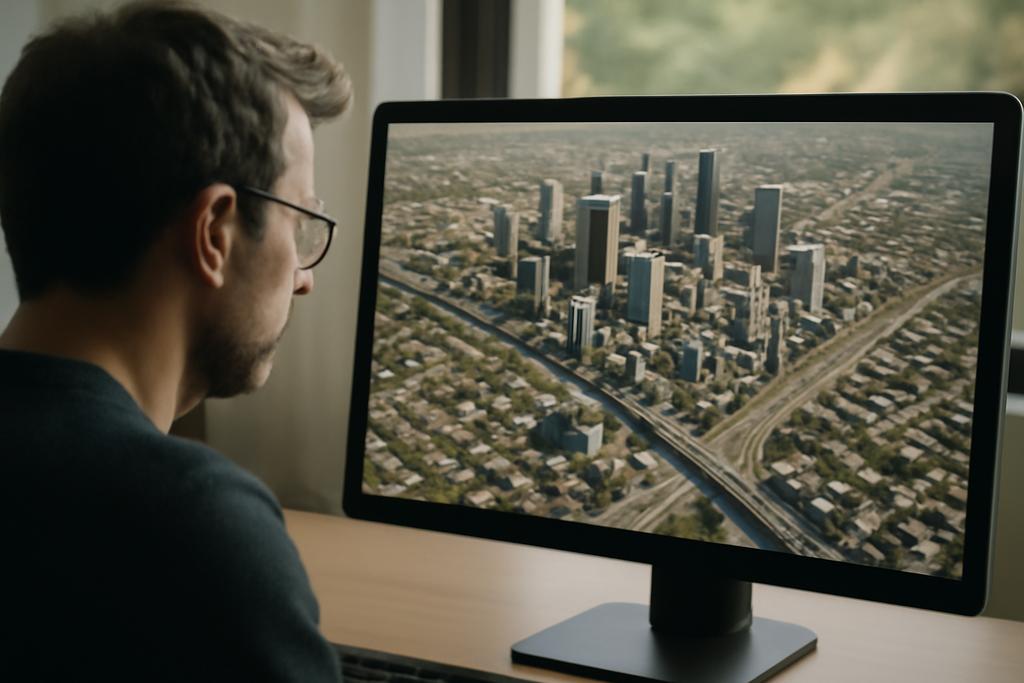Forget meticulously crafting virtual cities brick by brick. Researchers at Northwestern University and the Illinois Institute of Technology have developed a groundbreaking method that lets algorithms design entire metropolises, complete with realistic road networks and building distributions. Lead by Thomas Lechner, Ben Watson, and Uri Wilensky, the procedural city modeling project tackles a challenge that has long stumped computer scientists: replicating the organic complexity of urban development.
From Simple Rules, Complex Cities Emerge
The secret lies in agent-based modeling. Instead of trying to program every detail, the researchers created a digital world populated by autonomous “agents.” These agents, representing developers, builders, and even speculators, follow straightforward rules. A residential agent, for example, might prioritize building in areas with lower road density and proximity to green spaces, while commercial agents favor high-traffic zones.
The brilliance is in the emergent behavior. While each agent acts independently, their collective actions lead to patterns that strikingly resemble real-world urban development. Think of it like a flock of birds: each bird follows simple rules of flight, yet the flock as a whole exhibits complex, coordinated movements. Similarly, the interactions of these digital agents produce the intricate tapestry of a city.
Beyond Roads: A Holistic Approach to Urban Design
Previous attempts at procedural city generation often focused solely on road networks, using algorithms to create branching structures based on population density. While this approach yields plausible road maps, it lacks the richness and diversity of a real city. Lechner, Watson, and Wilensky’s model goes far beyond this by integrating multiple agents representing different types of development, from residential and commercial to industrial and potentially even public spaces. The resulting cities are not simply road networks overlaid on a landscape; they are organically growing ecosystems of buildings and infrastructure.
The researchers emphasize the versatility of their system. The only essential input is a terrain description – a digital map of elevation and water features. Users can then fine-tune various parameters, such as road connectivity, building density, and even cultural influences to shape the final result. This allows for a balance between algorithmic automation and artistic control, transforming the system into a powerful tool for urban planning and design.
The Promise of Procedural Cities
The implications extend far beyond the realm of computer graphics. This technology has immense potential for urban planning. Imagine using this model to simulate the effects of different zoning policies or transportation infrastructure on city growth and development. By visualizing various scenarios, urban planners can make data-driven decisions that optimize livability, efficiency, and sustainability.
The entertainment industry also stands to benefit greatly. Game developers could leverage this technology to create vast, detailed virtual worlds without the immense manual labor involved in traditional 3D modeling. This would lead to richer, more immersive gaming experiences, with dynamic cities that evolve and adapt over time. Filmmakers could also utilize this technology to create realistic backdrops for their movies, dramatically reducing the cost and effort required to build elaborate sets.
Looking Ahead: Refining the Model
While the current model already produces impressive results, the researchers acknowledge that there’s still room for improvement. They plan to add more sophisticated agents representing different types of development and infrastructure, such as highways, public transportation, and specialized buildings. They also aim to expand the cultural parameters of the model, allowing for the creation of cities reflecting diverse historical periods and urban styles. This ongoing development ensures that the model will continue to grow in accuracy, realism, and creative potential.
This research, supported by the National Science Foundation and in collaboration with Electronic Arts and SimCenter, marks a significant advance in the field of procedural generation. By combining the power of agent-based modeling with a focus on emergent behavior, Lechner, Watson, and Wilensky have opened up exciting new possibilities in urban design, game development, and beyond. Their work paves the way for a future where algorithms can not only design and build our virtual cities but also inform and improve the design of our real ones.










